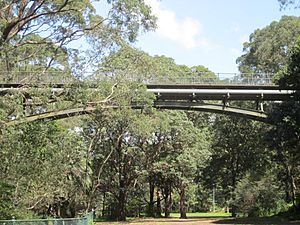Mosman Bay Sewage Aqueduct facts for kids
Quick facts for kids Mosman Bay Sewage Aqueduct |
|
|---|---|

View of Aqueduct showing sewage pipe below walkway
|
|
| Location | Avenue Road, Mosman, Mosman Council, New South Wales, Australia |
| Built | 1899–1901 |
| Architect | Sewerage Construction Branch; NSW Department of Public Works |
| Owner | Sydney Water |
| Official name: Mosman Bay Sewage Aqueduct; Aqueduct over Mosman's Bay | |
| Type | State heritage (built) |
| Designated | 18 November 1999 |
| Reference no. | 1328 |
| Type | Sewage Aqueduct |
| Category | Utilities – Sewerage |
| Builders | NSW Department of Public Works |
| Lua error in Module:Location_map at line 420: attempt to index field 'wikibase' (a nil value). | |
The Mosman Bay Sewage Aqueduct is a special bridge in Mosman, Australia. It's unique because it does two jobs at once. It carries sewage pipes across the water, and it also has a path for people to walk on. This historic structure was built a long time ago, between 1899 and 1901. It was designed by the NSW Department of Public Works. People also call it the Aqueduct over Mosman Bay. Today, Sydney Water owns and looks after this important piece of history. It was officially added to the New South Wales State Heritage Register in 1999, meaning it's protected for future generations.
Contents
Building the Mosman Bay Aqueduct
The Mosman Bay Sewage Aqueduct was built as part of a bigger plan. This plan was to create a sewage system for the areas of Neutral Bay and Mosman. These were some of the first sewage systems built on Sydney's lower north shore.
Why Was It Built?
The main goal was to carry sewage pipes across the head of Mosman Bay. But the designers also wanted the bridge to look good. They didn't want it to spoil the beautiful area. So, they decided to build a special arch bridge. They also added a walkway on top. This way, people could use it as a bridge too.
How Was It Built?
The bridge was designed in 1899. It features a strong steel arch that spans about 42.68 meters (140 feet). The steel used to build it actually came all the way from England. Because of shipping delays, construction didn't start until 1900. The aqueduct was mostly finished by 1901 and fully completed by 1904.
Changes Over Time
When it was first built, the aqueduct carried a large steel pipe. This pipe was replaced with a newer, welded steel pipe in 1937. Later, in 1971, two more pipes were added to carry even more sewage. At the same time, the wooden walkway was updated. The old timber slats were replaced with concrete blocks.
What Makes This Aqueduct Special?
The Mosman Bay Aqueduct is one of only two steel arch aqueducts in Sydney. The other one carried water pipes over the Lane Cove River. What makes the Mosman Bay Aqueduct extra special is that it's the only one with a path for people to walk on. It's a great example of engineering from the early 1900s.
Why the Aqueduct is Important
The Mosman Bay Aqueduct is listed on the New South Wales State Heritage Register. This means it's considered a very important historical site.
A Look at History
The aqueduct shows how Sydney's sewage systems developed. It was a key part of one of the first major sewage schemes in the area. It helps us understand how cities grew and managed waste in the past.
A Beautiful Design
Completed in 1901, the aqueduct is a stunning example of engineering from the Federation era. Its design fits well into the park setting. It shows how engineers could create useful structures that were also attractive.
A Community Connection
This aqueduct is a well-known landmark in Mosman. It's not just a historical structure; it's still used every day by people walking across it. It's a part of the local community's history and daily life.
Unique Construction
The bridge uses a lot of imported steel. This was quite rare for buildings at that time, especially outside of railway construction. Its unique steel arch design, combined with the pedestrian bridge, makes it a rare type of structure in New South Wales.

